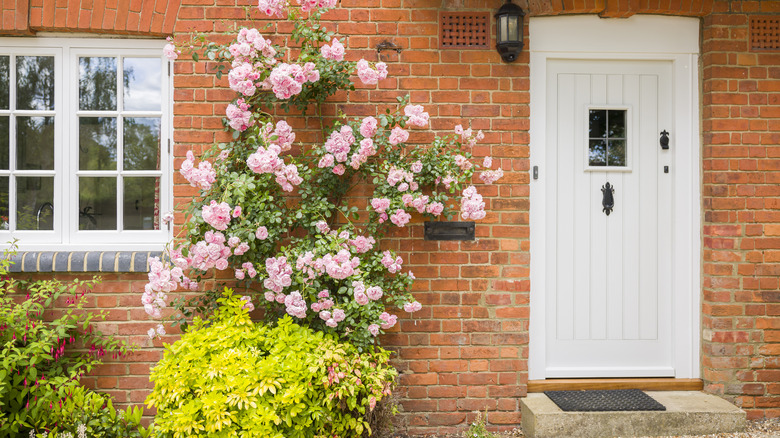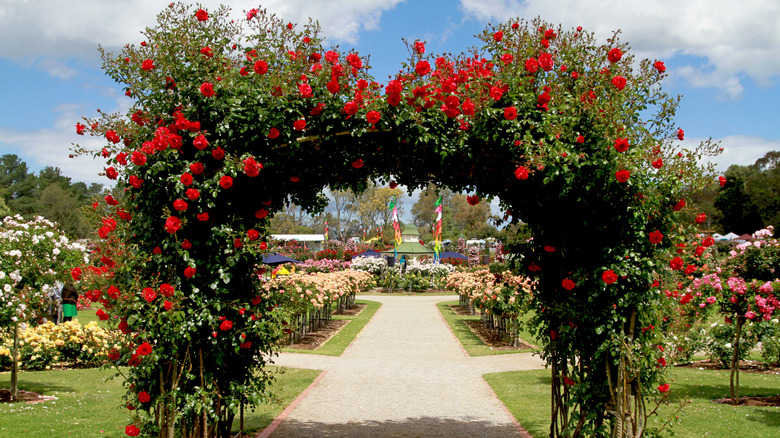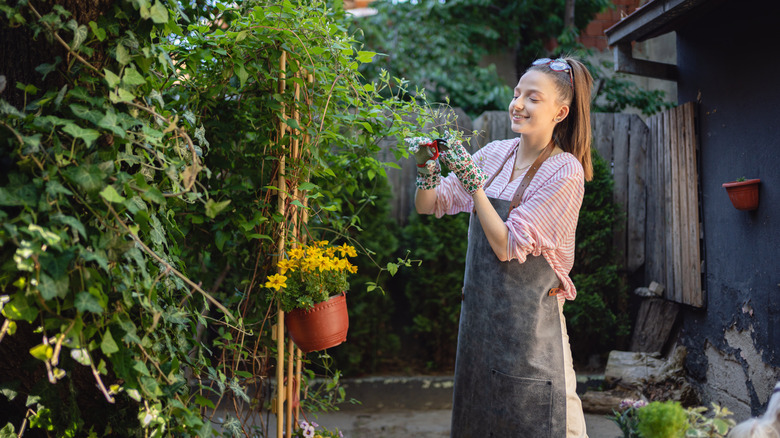Tips For Growing Climbing Roses For Gorgeous Towering Blooms
If you want to transform your city bungalow or suburban new-build house into a romantic cottage, there is no faster way than to incorporate a few stunning climbing roses. Something about them invokes nostalgic images of countryside houses and small villages, giving your backyard a touch of whimsy. They're elegant and understated while still packing a punch, thanks to their sheer size. Most varieties can grow up to 12 feet tall, while others can surpass those heights. However, to achieve those towering blooms, you need to ensure they have the best conditions in which to thrive. It's not enough to grow them on a trellis; there is some maintenance involved if you want your climbing roses to bust out in blooms.
First, you want to plant them against a structure. If they don't have a pergola, trellis, column, or arbor to climb on, climbing roses will ramble into a small hedge on the ground. This can be a beautiful ground cover, but they won't spontaneously begin to grow upwards unless you train them onto a structure. Doing so can also trigger more bountiful and bigger blooms. If you don't have the budget to buy such a support structure, you can easily create a garden trellis using a few closet staples. Second, you want to get into a pruning routine. Strategically cutting away old blooms and stems will encourage new shoots to form, creating a thicker, more eye-catching display. Here is a closer look at what to do to develop towering roses.
Tie climbing roses to support structures
Make sure you plant climbing roses in an area with plenty of sunshine. They need about six hours of full sun daily, so ensure you're not growing them in a shadowy backyard. The interesting thing about climbing roses is that they won't creep up a support structure like a vine. Without training, they will happily stay on the ground like a small shrub. If you are growing them on a trellis against a wall, plant the climbing roses 12 inches away from the structure. This will ensure the roots get plenty of rain since they won't be blocked by the roofline or gutter system above. If you're growing them on an arch or arbor (away from any walls or roofs), then you can plant the climbing roses right against the structure.
Once they start growing, you will need to tie the rose canes directly to the structure since they won't grip onto it on their own. Begin fastening the canes about 1.5 feet off the ground, and tie them to the trellis or structure at 1-foot increments. To promote more abundant blooms, you can twist the shoots around the structure or even bend them right down in a method known as "self-pegging." Climbing roses have hormones that allow only one bud to grow on one vine, but bending the stem helps suppress that hormone. If this hormone is suppressed, as many as 30 blooms can grow along the canes.
Pruning climbing roses can encourage blossoms
To promote the biggest blooms possible, avoid pruning your climbing roses for the first two years while they're still setting roots and becoming established. Cutting them back during this sensitive time can inhibit their growth. After that, a good rule of thumb is to prune just before they send out new growth. This is usually at the end of winter or the beginning of spring, so add climbing roses to your list of plants to prune in late winter to enjoy a stunning display. Start by cutting back any damaged or dying branches. Next, focus on lateral shoots. These are the side stems that grow horizontally from the main, woody canes. You can prune back up to ⅔ of their length.
Once your climbing roses are established, you may need to occasionally prune off large, thick, structural canes. Pruning some of the main foundational stems can help ensure you get flowers at the foot of the structure as well. Once the plant is four years old, remove one main stem a year. "When the main canes become very old, thick, and woody, it is best to remove them and start training younger and more pliable new main canes," Kristen Smith, rose product manager at Star Roses and Plants, told Homes & Gardens. If your climbing rose is overdue for a big trim, you may need to remove more canes, but restrict heavy pruning to every three or four years and do it after the first round of flowers fade, around June.


